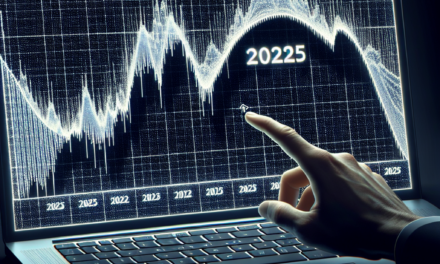“Market Momentum: Nasdaq and S&P 500 Futures Climb as Iowa Shakes Up Trump Trade Dynamics”
Introduction
In a surprising turn of events, the stock market is witnessing a notable shift as Nasdaq and S&P 500 futures experience an upward trajectory, driven by unexpected developments in Iowa that are influencing the so-called “Trump Trade.” This movement comes as investors and analysts closely monitor the political landscape and its potential impact on market dynamics. The Iowa surprise has injected a fresh wave of uncertainty and speculation, prompting market participants to reassess their strategies and positions. As the futures rise, attention is focused on how these political developments will shape economic policies and investor sentiment in the coming days.
Impact Of Iowa Surprise On Nasdaq Futures
In recent developments, the stock market has witnessed a notable shift, with Nasdaq and S&P 500 futures experiencing an upward trajectory. This change comes in the wake of unexpected political developments in Iowa, which have had a significant impact on what is commonly referred to as the “Trump Trade.” The term “Trump Trade” refers to the market trends and investor behaviors that have been influenced by the policies and rhetoric of former President Donald Trump. The Iowa surprise, therefore, has introduced a new dynamic into the market, prompting investors to reassess their strategies and expectations.
The Iowa surprise refers to unexpected political outcomes or shifts in voter sentiment that have the potential to influence national politics and, by extension, economic policies. Such surprises can lead to volatility in the stock market as investors react to the potential implications for trade, regulation, and fiscal policy. In this instance, the surprise has led to a reevaluation of the Trump Trade, which had been characterized by a focus on deregulation, tax cuts, and a strong emphasis on domestic manufacturing.
As investors digest the implications of the Iowa surprise, Nasdaq futures have shown resilience, rising in response to the changing political landscape. This increase can be attributed to several factors. Firstly, technology stocks, which are heavily represented in the Nasdaq index, have continued to perform well, driven by strong earnings reports and robust demand for digital services. The tech sector’s ability to adapt and thrive in various political climates has provided a buffer against potential market disruptions.
Moreover, the S&P 500 futures have also experienced an uptick, reflecting broader market optimism. This optimism is partly fueled by the belief that any political changes resulting from the Iowa surprise could lead to more balanced and predictable economic policies. Investors are hopeful that such policies would foster a stable environment for business growth and investment, thereby supporting the overall market.
Transitioning to the potential long-term effects, it is important to consider how the Iowa surprise might influence future market trends. If the political shifts lead to changes in trade policies or regulatory frameworks, sectors that were previously favored under the Trump administration might face new challenges. Conversely, industries that were less prioritized could see renewed interest and investment. This rebalancing could lead to a more diversified market, with opportunities for growth across a wider range of sectors.
Furthermore, the impact of the Iowa surprise on international trade relations cannot be overlooked. As the United States navigates its position on the global stage, any changes in trade policy could have ripple effects across global markets. Investors will be closely monitoring developments to gauge how these changes might affect multinational corporations and international supply chains.
In conclusion, the Iowa surprise has introduced a new layer of complexity to the stock market, influencing both Nasdaq and S&P 500 futures. As investors adjust to the evolving political landscape, the market is likely to experience fluctuations as it seeks equilibrium. While the immediate reaction has been positive, with futures rising, the long-term impact will depend on how political developments unfold and their subsequent effect on economic policies. As always, investors are advised to stay informed and consider a diversified approach to navigate the uncertainties that lie ahead.
S&P 500 Futures Reaction To Iowa Political Developments
In recent developments, the futures for the Nasdaq and S&P 500 have shown a notable rise, reflecting the market’s reaction to unexpected political shifts in Iowa that have influenced the so-called “Trump trade.” This term, which gained prominence following the 2016 U.S. presidential election, refers to the market trends and economic policies associated with former President Donald Trump, particularly those emphasizing deregulation, tax cuts, and infrastructure spending. The latest political developments in Iowa have introduced a new dynamic, prompting investors to reassess their strategies and expectations.
The Iowa surprise, as it is being referred to, has created ripples across the financial markets, with investors keenly observing how these changes might affect the broader economic landscape. The political landscape in Iowa has historically been a bellwether for national trends, and any significant shifts there can have far-reaching implications. As a result, the rise in Nasdaq and S&P 500 futures suggests that investors are anticipating potential policy changes or shifts in economic priorities that could emerge from these developments.
Moreover, the market’s response underscores the interconnectedness of politics and economics, where political events can swiftly alter market sentiment and investor behavior. The increase in futures indicates a degree of optimism or at least a recalibration of risk assessments among investors. This optimism may be fueled by the belief that new political dynamics could lead to favorable economic policies or, conversely, that the market is simply adjusting to a new status quo.
In addition to the political factors, it is essential to consider the broader economic context in which these developments are occurring. The U.S. economy has been navigating a complex landscape marked by inflationary pressures, supply chain disruptions, and evolving monetary policies. These factors have already been influencing market behavior, and the Iowa surprise adds another layer of complexity. Investors are likely weighing these elements as they interpret the implications of the political shifts.
Furthermore, the rise in futures could also be attributed to technical factors within the market. Traders often use futures as a tool to hedge against potential risks or to speculate on future market movements. The current uptick might reflect strategic positioning by market participants who are seeking to capitalize on anticipated changes or to protect their portfolios against potential volatility.
As the situation continues to unfold, it will be crucial for investors to remain vigilant and adaptable. The interplay between political developments and market reactions is inherently dynamic, and the full impact of the Iowa surprise on the Trump trade and broader market trends may take time to manifest. Investors will need to stay informed and be prepared to adjust their strategies as new information becomes available.
In conclusion, the rise in Nasdaq and S&P 500 futures amid the Iowa surprise highlights the intricate relationship between politics and the stock market. While the immediate reaction suggests a degree of optimism or strategic repositioning, the long-term implications remain uncertain. As always, investors must navigate these complexities with a keen eye on both political developments and economic indicators, ensuring that their decisions are informed by a comprehensive understanding of the evolving landscape.
Analyzing The Trump Trade In Light Of Iowa Results
In the wake of the recent Iowa results, the financial markets have been abuzz with activity, particularly concerning the so-called “Trump trade.” This term refers to the market trends and investment strategies that have been influenced by the policies and rhetoric of former President Donald Trump. The latest developments in Iowa have introduced a new dynamic, prompting investors to reassess their positions and strategies. As a result, Nasdaq and S&P 500 futures have experienced a notable rise, reflecting the market’s response to these political shifts.
To understand the implications of the Iowa results on the Trump trade, it is essential to consider the broader context of how political events can influence market behavior. Historically, markets have reacted to political developments that signal potential changes in economic policy, regulatory environments, and international trade relations. The Iowa results, therefore, serve as a barometer for investor sentiment regarding the future trajectory of these factors.
The rise in Nasdaq and S&P 500 futures suggests that investors are optimistic about the potential impact of the Iowa results on the market. This optimism may be driven by the perception that the results could lead to a more stable political environment, which in turn could foster economic growth and stability. Additionally, the results may be seen as a signal that certain policies associated with the Trump administration, such as tax cuts and deregulation, could continue to influence the market positively.
Moreover, the Iowa results have prompted a reevaluation of the sectors that are most likely to benefit from the Trump trade. Technology stocks, which are heavily represented in the Nasdaq index, have been a significant beneficiary of the Trump administration’s policies, particularly in terms of tax incentives and deregulation. The rise in Nasdaq futures indicates that investors remain confident in the growth prospects of the technology sector, despite the political uncertainties.
Similarly, the S&P 500, which encompasses a broader range of industries, has also seen a rise in futures. This suggests that investors are optimistic about the overall economic outlook and the potential for continued growth across various sectors. The S&P 500’s performance is often viewed as a proxy for the health of the U.S. economy, and its rise in futures indicates a positive sentiment among investors.
However, it is important to note that while the Iowa results have introduced a new dynamic to the Trump trade, they are not the sole factor influencing market behavior. Other elements, such as global economic conditions, interest rates, and geopolitical tensions, continue to play a significant role in shaping investor sentiment. Therefore, while the rise in Nasdaq and S&P 500 futures is a positive sign, it is crucial for investors to remain vigilant and consider the broader economic landscape.
In conclusion, the Iowa results have had a significant impact on the Trump trade, as evidenced by the rise in Nasdaq and S&P 500 futures. This development highlights the intricate relationship between political events and market behavior, underscoring the importance of staying informed and adaptable in an ever-changing economic environment. As investors navigate these complexities, the ability to anticipate and respond to political and economic shifts will be key to capitalizing on opportunities and mitigating risks in the market.
Nasdaq’s Performance Amid Political Uncertainty

In recent developments, the stock market has shown a notable shift, with Nasdaq and S&P 500 futures experiencing an upward trend. This movement comes in the wake of unexpected political events in Iowa, which have had a significant impact on what is commonly referred to as the “Trump Trade.” The term “Trump Trade” refers to the market dynamics influenced by the policies and rhetoric of former President Donald Trump, particularly those related to deregulation, tax cuts, and trade policies. As investors navigate the complexities of these political developments, the Nasdaq’s performance has become a focal point, reflecting broader market sentiments amid uncertainty.
The Nasdaq, known for its heavy concentration of technology stocks, often serves as a barometer for investor confidence in the tech sector. In recent days, the index has demonstrated resilience, buoyed by strong earnings reports from major tech companies. This positive performance is further amplified by the unexpected political shifts in Iowa, which have introduced a new layer of complexity to the market. Investors are now recalibrating their strategies, taking into account the potential implications of these political changes on future economic policies.
Moreover, the rise in Nasdaq and S&P 500 futures suggests a cautious optimism among investors. This optimism is not unfounded, as the tech sector continues to show robust growth potential, driven by innovation and increasing demand for digital solutions. However, the political landscape remains a critical factor, with the Iowa surprise adding an element of unpredictability. As a result, market participants are closely monitoring developments, seeking to understand how these changes might influence the broader economic environment.
In addition to the tech sector’s performance, the overall market sentiment is also shaped by macroeconomic indicators. Recent data on employment, inflation, and consumer spending have provided mixed signals, contributing to the market’s volatility. While some indicators suggest a strengthening economy, others point to potential challenges ahead. This dichotomy underscores the importance of a nuanced approach to investment, as market participants weigh the risks and opportunities presented by the current economic climate.
Furthermore, the impact of the Iowa surprise on the “Trump Trade” cannot be understated. The political developments have raised questions about the sustainability of policies that have been central to market dynamics in recent years. As investors assess the potential for policy shifts, there is a growing recognition of the need for diversification and risk management. This strategic recalibration is evident in the rising interest in sectors beyond technology, as investors seek to balance their portfolios in anticipation of potential changes.
In conclusion, the recent rise in Nasdaq and S&P 500 futures highlights the complex interplay between political developments and market performance. As the Iowa surprise continues to reverberate through the financial markets, investors are navigating a landscape marked by both opportunity and uncertainty. The Nasdaq’s performance amid this backdrop serves as a testament to the resilience of the tech sector, while also reflecting broader market sentiments. As the situation evolves, market participants will undoubtedly remain vigilant, adapting their strategies to align with the shifting political and economic landscape. Through careful analysis and strategic planning, investors can position themselves to capitalize on emerging trends while mitigating potential risks.
S&P 500’s Resilience To Political Surprises
In recent developments, the stock market has shown remarkable resilience, particularly the S&P 500, in the face of political surprises that have historically caused volatility. The latest example of this resilience is the market’s reaction to unexpected political shifts in Iowa, which have had a notable impact on what is often referred to as the “Trump Trade.” This term broadly encompasses the market trends and economic policies associated with the former president, which have continued to influence investor sentiment and market dynamics even after his tenure.
The Nasdaq and S&P 500 futures have risen, reflecting investor confidence despite the political upheaval. This upward movement in futures suggests that investors are increasingly adept at navigating political uncertainties, focusing instead on underlying economic fundamentals and corporate earnings. The Iowa surprise, which caught many political analysts off guard, has not deterred the market’s upward trajectory. Instead, it has highlighted the adaptability of investors who are now more inclined to weigh a broader range of factors before making investment decisions.
One of the key reasons for the S&P 500’s resilience is the diversification of its constituent companies. The index comprises a wide array of sectors, including technology, healthcare, and consumer goods, which collectively provide a buffer against sector-specific shocks. This diversification allows the S&P 500 to absorb political surprises more effectively than indices that are heavily weighted towards a single sector. Moreover, the robust performance of technology stocks, which have been a significant driver of the index’s gains, continues to bolster the S&P 500’s overall stability.
In addition to diversification, the current economic environment has played a crucial role in supporting the market’s resilience. With inflationary pressures showing signs of easing and the Federal Reserve adopting a more measured approach to interest rate hikes, investors have found renewed confidence in the market’s long-term prospects. This macroeconomic backdrop has provided a foundation for the S&P 500 to weather political uncertainties, as investors anticipate a more stable economic landscape in the coming months.
Furthermore, corporate earnings have remained strong, with many companies reporting better-than-expected results. This has reinforced investor confidence, as robust earnings indicate that businesses are effectively managing challenges and capitalizing on opportunities. The positive earnings reports have also helped to offset any negative sentiment stemming from political developments, as investors focus on the tangible performance of companies rather than speculative political outcomes.
It is also worth noting that the global economic context has contributed to the S&P 500’s resilience. As international markets continue to recover from the disruptions caused by the pandemic, there is a growing sense of optimism about global economic growth. This optimism has spilled over into U.S. markets, providing additional support for indices like the S&P 500. Investors are increasingly looking beyond domestic political events, considering the broader global economic picture when making investment decisions.
In conclusion, the S&P 500’s ability to maintain its upward momentum amid political surprises, such as the recent developments in Iowa, underscores the market’s resilience. Through diversification, a supportive economic environment, strong corporate earnings, and a global perspective, the index has demonstrated its capacity to navigate uncertainties. As investors continue to adapt to the evolving political and economic landscape, the S&P 500 remains a bellwether of market confidence and stability.
The Role Of Political Events In Stock Market Volatility
The stock market is a complex ecosystem influenced by a myriad of factors, among which political events play a significant role. Recently, the futures for the Nasdaq and S&P 500 indices experienced an upward trend, a movement that can be attributed to the unexpected outcomes of the Iowa caucuses and their subsequent impact on what has been termed the “Trump Trade.” This phenomenon underscores the intricate relationship between political developments and market volatility, highlighting how investor sentiment can be swayed by shifts in the political landscape.
Political events often serve as catalysts for market fluctuations, as they introduce elements of uncertainty and potential policy changes that can affect economic conditions. The Iowa caucuses, a critical early event in the U.S. presidential election cycle, have historically been a bellwether for candidate momentum. This year, the results defied expectations, leading to a reassessment of the political climate and its implications for future economic policies. As investors digest these outcomes, their reactions are reflected in the movements of major stock indices.
The concept of the “Trump Trade” emerged following the 2016 U.S. presidential election, characterized by a market rally driven by expectations of pro-business policies, including tax cuts, deregulation, and infrastructure spending. These anticipated measures were perceived as beneficial for corporate earnings and economic growth, prompting a surge in stock prices. However, political events such as the Iowa caucuses can disrupt these expectations, leading to adjustments in market positioning.
In the wake of the Iowa surprise, investors are recalibrating their strategies, considering the potential for shifts in policy priorities depending on the evolving political landscape. This recalibration is evident in the rise of Nasdaq and S&P 500 futures, as market participants weigh the implications of a changing political environment on sectors that have been central to the Trump Trade, such as technology and financials. The technology sector, in particular, has been a significant beneficiary of the Trump administration’s policies, and any perceived threat to this status quo can lead to heightened market sensitivity.
Moreover, the interconnectedness of global markets means that political events in one country can have ripple effects across the world. Investors are increasingly aware of the potential for geopolitical developments to influence trade relations, regulatory frameworks, and economic growth prospects. As such, political events like the Iowa caucuses are not only domestic concerns but also global ones, with the potential to impact international investor sentiment and capital flows.
In conclusion, the recent rise in Nasdaq and S&P 500 futures amid the Iowa surprise serves as a reminder of the profound influence political events can have on stock market volatility. As investors navigate this complex landscape, they must remain vigilant, continuously assessing the potential impacts of political developments on their portfolios. The dynamic interplay between politics and markets underscores the importance of staying informed and adaptable in an ever-changing environment. As the political narrative unfolds, its implications for the stock market will continue to be a focal point for investors seeking to understand and anticipate the forces shaping the financial landscape.
Future Projections For Nasdaq And S&P 500 Post-Iowa Results
In the wake of the surprising results from the Iowa caucuses, the financial markets have been closely monitoring the potential implications for the broader economic landscape. The Nasdaq and S&P 500 futures have shown a notable rise, reflecting investor sentiment and the anticipated impact on what has been termed the “Trump trade.” This term refers to the market trends and economic policies associated with the Trump administration, which have significantly influenced investment strategies and market movements over the past few years. As the political landscape shifts, so too do the expectations for future market performance.
The unexpected outcomes in Iowa have introduced a new layer of uncertainty, prompting investors to reassess their positions and strategies. Historically, political events have had a profound impact on market dynamics, and the Iowa results are no exception. The rise in Nasdaq and S&P 500 futures suggests that investors are cautiously optimistic about the potential for policy shifts that could favor economic growth and stability. This optimism is tempered by the inherent unpredictability of political processes, which can lead to volatility in the markets.
Moreover, the implications of the Iowa results extend beyond immediate market reactions. Investors are considering the long-term effects on sectors that have been particularly sensitive to policy changes under the Trump administration. For instance, technology and healthcare stocks, which are heavily represented in the Nasdaq, may experience fluctuations as new policy directions are anticipated. Similarly, the S&P 500, with its diverse range of sectors, could see varied impacts depending on how political developments unfold.
In addition to sector-specific considerations, broader economic indicators are also playing a role in shaping future projections for the Nasdaq and S&P 500. Economic data, such as employment figures, consumer confidence, and corporate earnings, continue to influence market sentiment. The interplay between these indicators and political developments creates a complex environment for investors to navigate. As such, market participants are closely watching for any signals that could provide clarity on the future direction of economic policy.
Furthermore, the global economic context cannot be ignored when assessing future projections for these indices. International trade relations, geopolitical tensions, and global economic growth are all factors that could influence the performance of the Nasdaq and S&P 500. The interconnectedness of global markets means that developments in one region can have ripple effects across the world, adding another layer of complexity to market forecasts.
In light of these considerations, investors are likely to adopt a cautious yet opportunistic approach. Diversification remains a key strategy, as it allows investors to mitigate risks while capitalizing on potential opportunities. Additionally, staying informed about both domestic and international developments will be crucial for making informed investment decisions.
In conclusion, the rise in Nasdaq and S&P 500 futures following the Iowa surprise reflects a nuanced market response to evolving political and economic conditions. While optimism prevails, it is tempered by the recognition of potential volatility and uncertainty. As investors navigate this complex landscape, they will need to remain vigilant and adaptable, ready to respond to new information and changing circumstances. The future projections for these indices will depend on a multitude of factors, each contributing to the intricate tapestry of the global financial markets.
Q&A
1. **What caused the Nasdaq and S&P 500 futures to rise?**
The rise was influenced by a surprising outcome in Iowa that impacted the Trump trade.
2. **What is the Trump trade?**
The Trump trade refers to market movements and investment strategies based on policies and expectations associated with Donald Trump’s presidency.
3. **How did the Iowa surprise affect the stock market?**
The unexpected results in Iowa led to increased investor optimism, boosting futures for major indices like Nasdaq and S&P 500.
4. **Which sectors benefited the most from the futures rise?**
Typically, sectors like technology and financials might see gains due to increased investor confidence in growth and policy stability.
5. **What are Nasdaq futures?**
Nasdaq futures are financial contracts that speculate on the future value of the Nasdaq index, allowing investors to hedge or speculate on market movements.
6. **What are S&P 500 futures?**
S&P 500 futures are contracts that predict the future value of the S&P 500 index, used by investors to manage risk or speculate on market trends.
7. **What is the significance of futures rising in the stock market?**
Rising futures often indicate positive investor sentiment and expectations of market growth, potentially leading to higher stock prices when markets open.
Conclusion
The recent rise in Nasdaq and S&P 500 futures can be attributed to the unexpected outcomes in Iowa, which have influenced market perceptions regarding the Trump trade policies. This development suggests that investors are reacting positively to the potential shifts in political dynamics, which could lead to changes in trade and economic policies. The market’s response indicates a renewed optimism among investors, who are anticipating that these changes might foster a more favorable business environment. As a result, the futures’ rise reflects a broader sentiment of confidence in the market’s ability to adapt and thrive amid political surprises.





